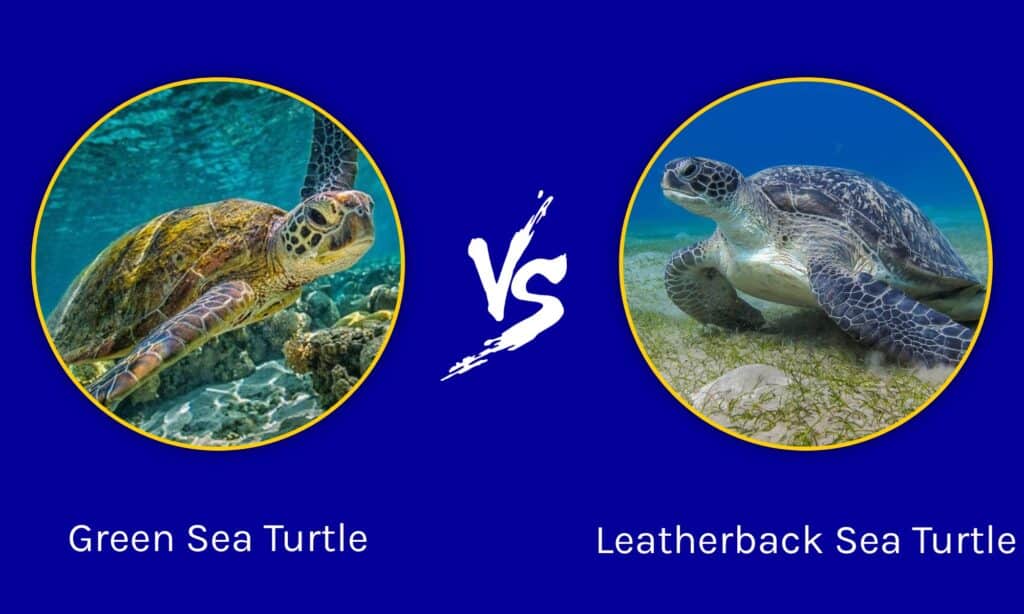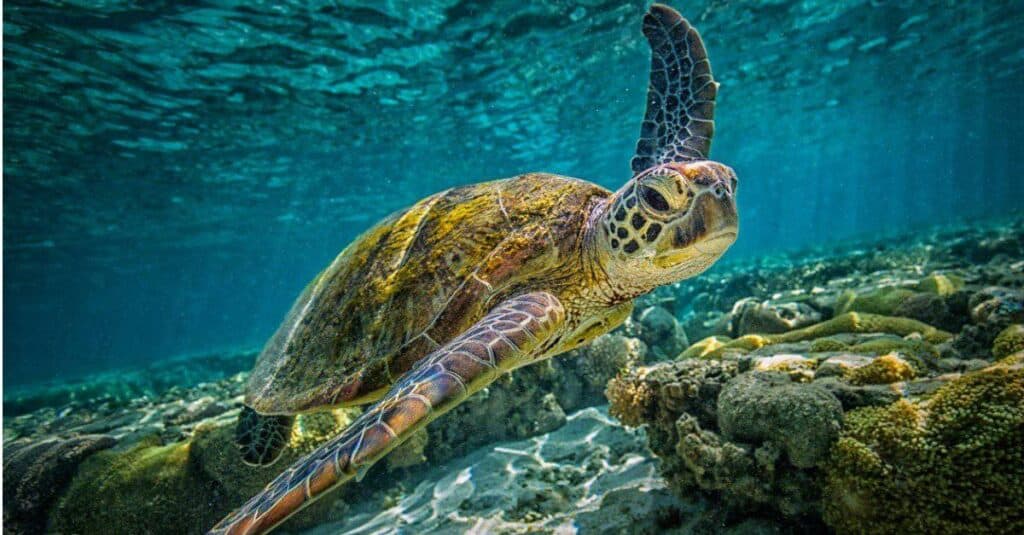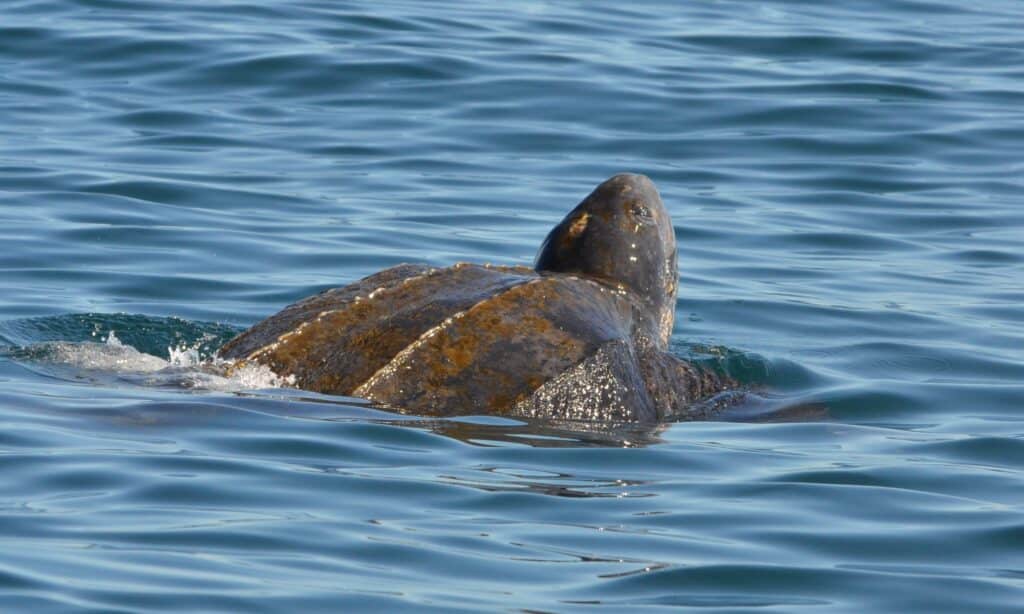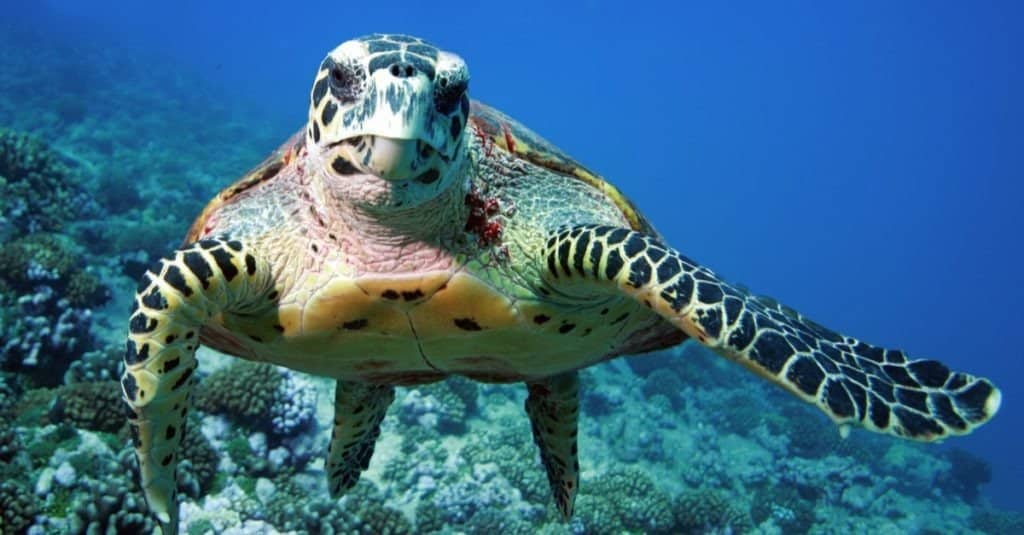There are seven species of sea turtles across the world, each with its habits, habitats, and appearance. Despite sea turtles, as a group, being quite similar, the individual species are incredibly diverse and have some unique adaptations. Of the seven species, we are going to compare two of the most famous; the green sea turtle vs the leatherback. As far as sea turtles go, these two are probably the most different. Let’s explore a bit more about these amazing marine reptiles together!
Comparing a green sea turtle and a leatherback

| Green sea turtle | Leatherback sea turtle | |
|---|---|---|
| Shell | Hard-shelled turtle. Rounded shape. | Leathery. Member of the genus Dermochelys. |
| Size | 150-419 lbs, with a maximum of 871 lbs. | 600-900 lbs, with a maximum of 2,019 lb. Largest non-crocodilian reptile in the world. |
| Appearance | Patterned shells, often marbled with variegated rays. Brown, black, or yellowish shell. Spotted brown limbs. | Dark gray to black across the entire body. Large, leathery shell in the shape of a teardrop. Longest fins by proportion of any turtle. |
| Distribution | Tropical and subtropical oceans worldwide. Two distinct populations in the Atlantic and eastern Pacific. | Widest distribution of any sea turtle species. Reaches from Alaska and Norway to South Africa and the southern tip of New Zealand. |
| Diet | Begin life as carnivorous, but turn herbivorous as they mature. | Jellyfish. |
| Conservation status | Endangered. | Vulnerable. |
The Key Differences Between Green Sea Turtles and Leatherbacks
The key differences between green sea turtles and leatherbacks are shell, size, appearance, distribution, diet, and conservation status.
Sea turtles are generally similar, with the exception of the leatherback. Comparing any sea turtle to the leatherback is relatively easy, especially with how different these turtles are from the other living sea turtles. Green sea turtles, along with five other species of sea turtle, are known as cheloniid turtles, indicating they have a hard shell. Leatherbacks are the only sea turtle species that belong to the dermochelyid category, meaning they have leathery shells.
Aside from the shells, green sea turtles are smaller than leatherbacks. Leatherbacks aren’t just large, they are record-breakingly large. Green sea turtles are the third-largest sea turtle species, behind the loggerhead and the leatherback, but the leatherback is solidly in first place. They are known as the largest non-crocodilian reptiles in the world and can average as much as 847 lbs.
Additionally, the diets of these two turtles are distinctly different. Green sea turtles go through a two-stage process as they age, switching from a carnivorous diet to an herbivorous one. Leatherbacks live their entire lives exclusively eating jellyfish.
Other differences between the green sea turtle and the leatherback will be explored in more detail below.
Green Sea Turtle vs Leatherback: Shell

Leatherbacks are known for their large, leathery shells.
©iStock.com/CaronB
The green sea turtle is a cheloniid, or hard-shelled, turtle. All species of sea turtle, besides the leatherback, are cheloniids. While no sea turtle can retract into their shells, the hard carapace of the green turtle provides protection from predators.
The shells of the leatherback are quite distinctive and give them their name. Leatherbacks are the only members of the dermochelyid category, meaning they have leathery shells. Their shells are made with a thick, oily, and leathery skin that makes up their entire carapace. Additionally, this tough skin is covered with small osteoderms (bony deposits) and totally lacks beta-keratin.
Green Sea Turtle vs Leatherback: Size

The green sea turtle is the third-largest sea turtle.
©iStock.com/Greg Sullavan
The green sea turtle is the third-largest sea turtle, behind the loggerhead and the leatherback. On average, green turtles weigh around 150-419 lbs and have a shell that often reaches 5 feet long. The largest green sea turtle ever recorded weighed 871 lbs.
Leatherback sea turtles are truly massive. These turtles are the largest non-crocodilian reptiles in the world and can weigh around 550-1,550 lbs. The two largest individuals ever recorded measured 1,433 and 2,019 lbs. Their total length averages around 6-7.2 feet.
Green Sea Turtle vs Leatherback: Appearance

Leatherbacks have ridged shells and black bodies.
©iStock.com/jtstewartphoto
The green sea turtle isn’t actually green but gets its name from the green fat that can be found under its shells, likely the result of its seagrass diet. Green sea turtles have round shells, often with beautiful patterns, including marbling, spotting, and variegated rays. The underside of the turtles are pale yellow, and their head and limbs are spotted brown or black.
Leatherbacks have a large leather shell that is in the shape of an oval. Additionally, their entire bodies, including their shells and limbs, are dark gray or black. They will occasionally have white spotting on their shells, and the underside of their body is lightly colored.
Green Sea Turtle vs Leatherback: Distribution
The green sea turtle is widely distributed across the tropical and subtropical waters of the world. There are two subpopulations of green turtles; one in the Atlantic and one in the eastern Pacific. The largest populations in the world can be found along the Great Barrier Reef and in the Caribbean Sea.
Leatherbacks are the most widely distributed sea turtles in the world. They live in all tropical and subtropical oceans, with a range that even extends into the Arctic Circle. Their northern range reaches Alaska and Norway, and their southern range reaches South Africa and the southern tip of New Zealand.
Green Sea Turtle vs Leatherback: Diet
Green sea turtles begin their lives as carnivores, mostly eating fish eggs, small jellyfish, and crustaceans. As they mature, however, they begin to feed on seagrass. Eventually, they switch their diets entirely to seagrass and algae, causing their fat to turn green, giving them their name.
Leatherbacks have a specific diet and exclusively feed on jellyfish. In fact, leatherbacks help keep jellyfish populations in check due to how many they can eat as they travel. Unfortunately, leatherbacks often mistake floating plastic for jellies and often die after ingesting bags, bottles, or other debris.
Green Sea Turtle vs Leatherback: Conservation status

Sea turtles are threatened by poaching, pollution, boat strikes, and more.
©Achimdiver/Shutterstock.com
All sea turtles in the world are currently endangered. Within the species, however, there are more specific ratings and threats.
Green sea turtles are listed as Endangered by the IUCN and the WWF, primarily due to their historic exploitation by humans for food and other resources. Other threats include pollution and habitat destruction.
Leatherbacks are listed as Vulnerable and are at less of a risk than other sea turtle species. This is primarily because leatherbacks aren’t good to eat due to their oil content, and once they reach maturity, few things can threaten them. Still, plastics, boat strikes, and nest destruction are extremely common.
The photo featured at the top of this post is © Isabelle Kuehn/Shutterstock.com
Thank you for reading! Have some feedback for us? Contact the AZ Animals editorial team.






